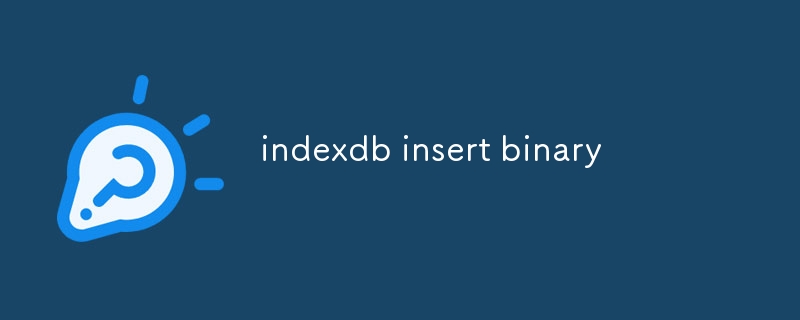indexdb 삽입 바이너리
이 글은 바이너리 데이터를 IndexedDB에 효율적으로 삽입하기 위한 포괄적인 가이드를 제공합니다. 바이너리 데이터를 배열 버퍼로 변환하고, 객체 저장소, 트랜잭션 및 객체를 생성하고, 객체의

바이너리 데이터를 IndexedDB에 효율적으로 삽입하는 방법
IndexedDB는 바이너리 데이터를 포함한 다양한 유형의 데이터를 저장하는 데 사용할 수 있는 강력한 데이터 저장 API입니다. IndexedDB에 바이너리 데이터를 효율적으로 삽입하려면 다음 단계를 따르세요.
1. 바이너리 데이터를 배열 버퍼로 변환: IndexedDB는 ArrayBuffer 객체와 함께 작동하므로 먼저 바이너리 데이터를 배열 버퍼로 변환해야 합니다. 이 목적으로 ArrayBuffer.from() 메서드를 사용할 수 있습니다.ArrayBuffer.from() method for this purpose.
2. Create a new IndexedDB object store: An object store is a container for data in IndexedDB. You need to create a new object store to store your binary data.
3. Create a new IndexedDB transaction: A transaction is a unit of work in IndexedDB. You need to create a new transaction to insert your binary data.
4. Create a new IndexedDB object: An object is a representation of a record in IndexedDB. You need to create a new object to store your binary data.
5. Set the value of the object to the array buffer: The value of an object can be set to an array buffer. Set the value of your object to the array buffer that you created in step 1.
6. Add the object to the object store: Add the object to the object store that you created in step 2.
7. Commit the transaction: Once you have added the object to the object store, you need to commit the transaction to save the changes.
Example:
// Create an array buffer from binary data
const buffer = ArrayBuffer.from(binaryData);
// Create a new object store
const store = db.createObjectStore("myBinaryData", { keyPath: "id", autoIncrement: true });
// Create a transaction
const transaction = db.transaction(["myBinaryData"], "readwrite");
// Create a new object
const object = transaction.objectStore("myBinaryData").create({});
// Set the value of the object to the array buffer
object.value = buffer;
// Add the object to the object store
transaction.objectStore("myBinaryData").add(object);
// Commit the transaction
transaction.commit();Can I use IndexedDB to store images as binary objects?
Yes, you can use IndexedDB to store images as binary objects. To store an image as a binary object in IndexedDB, follow these steps:
1. Read the image file as an array buffer: Use the FileReader
2. 새 IndexedDB 객체 저장소 만들기: 객체 저장소는 IndexedDB의 데이터를 위한 컨테이너입니다. 바이너리 데이터를 저장하려면 새 개체 저장소를 만들어야 합니다.
3. 새로운 IndexedDB 트랜잭션 생성: 트랜잭션은 IndexedDB의 작업 단위입니다. 바이너리 데이터를 삽입하려면 새 트랜잭션을 생성해야 합니다.
4. 새 IndexedDB 개체 만들기:
개체는 IndexedDB의 레코드를 표현한 것입니다. 바이너리 데이터를 저장하려면 새 개체를 만들어야 합니다.5. 객체의 값을 배열 버퍼로 설정하세요:
객체의 값을 배열 버퍼로 설정할 수 있습니다. 개체 값을 1단계에서 생성한 배열 버퍼로 설정합니다.6. 객체 저장소에 객체 추가:
2단계에서 생성한 객체 저장소에 객체를 추가합니다.7. 트랜잭션 커밋:
객체 저장소에 객체를 추가한 후에는 트랜잭션을 커밋하여 변경 사항을 저장해야 합니다.예:
🎜rrreee🎜IndexedDB를 사용하여 이미지를 바이너리 객체로 저장할 수 있나요?🎜🎜🎜 예, IndexedDB를 사용하여 이미지를 바이너리 개체로 저장할 수 있습니다.🎜 이미지를 IndexedDB에 바이너리 개체로 저장하려면 다음 단계를 따르세요.🎜🎜🎜1. 이미지 파일을 배열 버퍼로 읽기:🎜FileReader API를 사용하여 이미지 파일을 배열 버퍼로 읽습니다.🎜🎜🎜2. 배열 버퍼를 base64 문자열로 변환:🎜 IndexedDB는 배열 버퍼를 직접 저장하는 것을 지원하지 않습니다. IndexedDB에 저장하기 전에 배열 버퍼를 base64 문자열로 변환해야 합니다.🎜🎜🎜3. IndexedDB에 base64 문자열 삽입:🎜 이전 섹션에 설명된 단계를 사용하여 base64 문자열을 IndexedDB에 삽입합니다.🎜🎜IndexedDB에 이진 데이터를 저장할 때의 제한 사항은 무엇입니까?🎜🎜🎜IndexedDB에 이진 데이터를 저장하는 데에는 몇 가지 제한 사항이 있습니다. 🎜🎜🎜🎜1. 크기 제한:🎜 IndexedDB에는 데이터베이스당 2^31-1바이트의 크기 제한이 있습니다. 이는 단일 IndexedDB 데이터베이스에 2GB 이상의 바이너리 데이터를 저장할 수 없음을 의미합니다.🎜🎜🎜2. 성능:🎜 IndexedDB에 이진 데이터를 저장하는 것은 문자열이나 숫자와 같은 다른 유형의 데이터를 저장하는 것보다 느릴 수 있습니다. 이는 IndexedDB가 바이너리 데이터를 저장하기 전에 base64 문자열로 변환해야 하기 때문에 시간이 많이 걸릴 수 있는 프로세스입니다.🎜🎜🎜3. 호환성:🎜 IndexedDB는 모든 브라우저에서 지원되지 않습니다. 이는 IndexedDB를 사용하여 모든 브라우저에서 바이너리 데이터를 저장하지 못할 수도 있음을 의미합니다.🎜위 내용은 indexdb 삽입 바이너리의 상세 내용입니다. 자세한 내용은 PHP 중국어 웹사이트의 기타 관련 기사를 참조하세요!

핫 AI 도구

Undresser.AI Undress
사실적인 누드 사진을 만들기 위한 AI 기반 앱

AI Clothes Remover
사진에서 옷을 제거하는 온라인 AI 도구입니다.

Undress AI Tool
무료로 이미지를 벗다

Clothoff.io
AI 옷 제거제

Video Face Swap
완전히 무료인 AI 얼굴 교환 도구를 사용하여 모든 비디오의 얼굴을 쉽게 바꾸세요!

인기 기사

뜨거운 도구

메모장++7.3.1
사용하기 쉬운 무료 코드 편집기

SublimeText3 중국어 버전
중국어 버전, 사용하기 매우 쉽습니다.

스튜디오 13.0.1 보내기
강력한 PHP 통합 개발 환경

드림위버 CS6
시각적 웹 개발 도구

SublimeText3 Mac 버전
신 수준의 코드 편집 소프트웨어(SublimeText3)

뜨거운 주제
 7940
7940
 15
15
 1652
1652
 14
14
 1412
1412
 52
52
 1303
1303
 25
25
 1250
1250
 29
29


